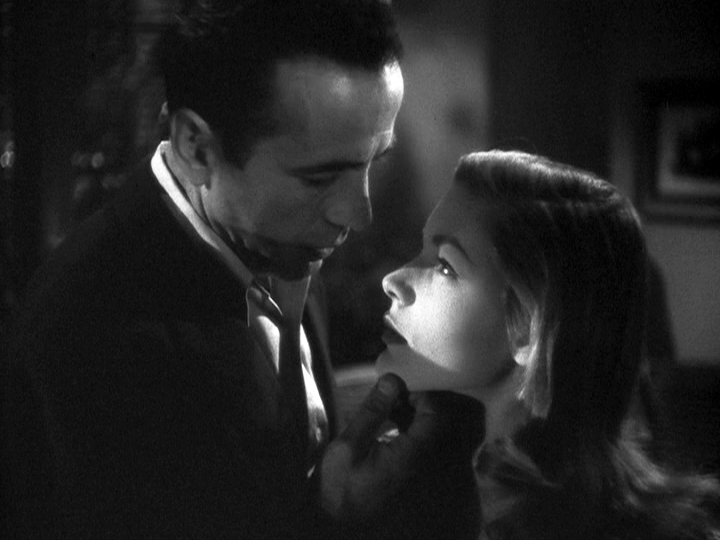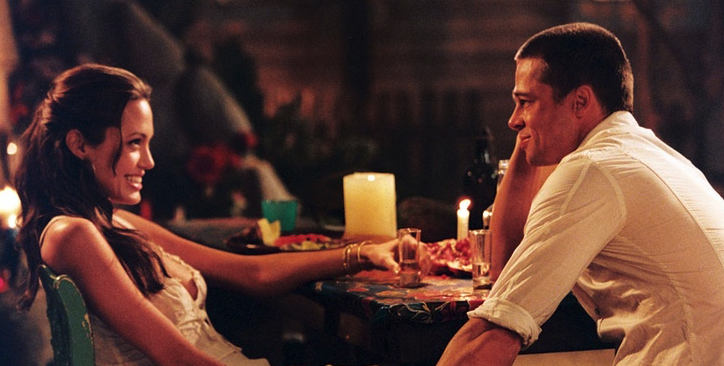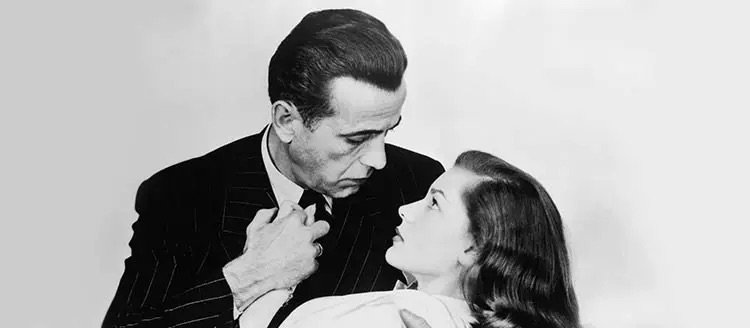
CHEMISTRY
REEL REACTIONS CAPTURED ON SCREEN
“Movies aren’t real life” goes the popular if pessimistic adage — except sometimes, the connections happening between two performers — actually are.
To Have and Have Not (1944)
Mr. & Mrs. Smith (2005)
Watch Episode 4 now.

Sorry – I just fell asleep. This is a nice scientific explanation for the what – but how about the why? What science can explain that? In the 90s rom com gem Sleepless in Seattle (1993), Annie’s brother Dennis Reed, brought perfectly to wonky life by David Hyde Pierce, says, “Annie, when you’re attracted to someone, it just means that your subconscious is attracted to their subconscious, subconsciously. So what we think of as fate is just two neuroses knowing that they are a perfect match.” Thankfully, we’ve evolved past the 90s, finding “a one true love” or a “soulmate” aren’t the only choices or pursuits in life. But it’s true that a lot of what happens is unconscious, and unexplained. Its mystery is part of its gravitational pull.
And – we’re not talking about love, necessarily. Chemistry can lead to love – but it can also lead to the sound of the hotel door clicking shut the next morning. How things begin is not always an indication of where they’ll go, and in this way, this episode’s two films diverge.
In her biography, By Myself (1978), Lauren Bacall wrote, “If there was one thing I had never been, it was mysterious, and if there was one thing I had never done, it was not talk.” Which flies in the face of her performance as slim in the 1944 classic, To Have and Have Not. She is both mysterious and more slightly spoken, not a chatterbox like our stars of Double Indemnity (1944).
Both Bogey and Pitt had the incredible privilege of starring with so many incredible leading women of the Hollywood of their times. But few of these films capture on screen chemistry like these two. Bogey and Bacall made a number of classic films together – The Big Sleep (1946), Key Largo (1948), In a Lonely Place (1950) – but the screen doesn’t quite sizzle the same with those. A runner up to To Have has to be Casablanca (1942), with Ingrid Bergman’s luminescence at its center, and Bogey’s gaze (and everyone else’s) just outside it.
YOU DON’T HAVE TO SAY ANYTHING, AND YOU DON’T HAVE TO DO ANYTHING
When I was in 5th grade, the first time I saw Marcy Katz, near a turtle-shaped climbing structure in a park playground in California, it hit me. In my 20s, when I saw Christopher Simiano on the middle of a dance floor in Provincetown – same feeling. And when I met Amy Anderson in a high rise in New York – you get where this is going. Sometimes, when you meet someone, your body and mind are called to attention. There is just something about the other person that draws you in. And different from a work of art, or a piece of music, or a vintage car, this feeling is romantic and or sexual in nature.
This is “love at first sight,” or “infatuation,” an “instant crush,” “twitterpated” if you’re Bambi, or simply, “chemistry.” We have all experienced it, or been around two other people experiencing it. Scientists tell us that what’s happening is a release of both dopamine (which activates “reward centers” in the brain) and oxytocin (which helps develop bonds), and when “butterflies” happen, it’s cortisol being rushed…
And with Pitt, the list is even longer, including Gwenyth Paltrow, Claire Forlani, Catherine Zeta Jones, Julia Roberts, Cate Blanchett, Jessica Chastain, and more – but as much as he’s a generational beauty, he’s a bit of an everyman, a canvas on which his co-star’s performances stretch. And the chemistry doesn’t always combust. Take 2016’s Allied, for example, praised for its costumes and production design, but criticized in part due to what many felt was a lack of chemistry between him and co-star Marion Cotillard.
Science also points to body scents, and pheromones, when it comes to chemistry. But other than Smell-O-Vision in the 1950s, cinema is primarily a two sense game – sight and sound. Thus, it’s the eyes that give the actors’ hearts away. Which brings us to the first scene between Bogey and Bacall in To Have, when, as Slim, she coos, “Anybody got a match?” The camera lingers on Bogey’s Steve as his eyes do all the talking.
“Steve” isn’t his character’s name – that’s Harry Morgan. But “Steve” is short for “stevedore,” which were men who worked the docks. And Bacall plays Marie Browning, but Steve gives her the nickname “Slim,” which was the term of endearment Director Howard Hawks’ gave his gorgeous wife Nancy. Like Bogey and Bacall, he was also more than twenty years her senior. It was she who saw a model named Betty Joan Perske (Bacall before Bacall) on the cover of Harper’s Bazaar in 1943 and suggested Howard look into her. She isn’t smiling, but the cover still packs a punch. (For another example of lily padding from modeling to video and back, check out this year’s candid, nostalgic and surprisingly powerful documentary The Supermodels 2023.)
For all his great filmography, we never got to see Bogey smiling much either. His gin-soaked visage was given more to scowling, and growling. But sit and watch, in “the” scene of the film, around 40 minutes in. After Bacall delivers the line heard round the world, and the door shuts – we see something more rare than the most endangered of species cross his face: a smile.
Fast forward to similar electricity, also staged in a doorway, in the first few minutes of Mr. & Mrs., when Jolie’s Jane introduces herself to Pitt’s John. They share a smile while they wait for the violence outside to pass, and we’re launched into a first-date-montage that features more eyes, smiles, and, well, more. In the film, marriage is the central topic at hand. Jolie said her former marriages, to Jonny Lee Miller and Billy Bob Thornton, helped found her interest in the role. Going through many marriages is as old a Hollywood custom as there is, and I’ve always thought, you’re working with some of the most beautiful and talented people in the world – wouldn’t you?
But the chemistry between these two shines more toward the middle of the film, when the plot takes off, during the glossy dinner scene around forty minutes in. A pas de deux with martinis, steak knives, and salty exchanges like:
JOHN
So how’s work?
JANE
Actually, we had a little trouble with the commission.
JOHN
Is that right?
JANE
Double booking with another firm. Green beans?
JOHN
No thank you.
JANE
You’ll have some.
JOHN
Well I hope everything works out okay.
JANE
It hasn’t yet.
(pause)
But it will.
It’s no Hemingway, Faulkner or Furthman (the trio writing team behind To Have), but Mr. & Mrs. writer and director Doug Liman does prize good banter (see 1996’s Swingers an 1999’s Go).
Here, the husband knows, and the wife knows, but the husband doesn’t know if the wife knows the husband knows, whereas the wife knows the husband knows she knows – or is it vice versa? The couple’s eyes are doing even more elegant work than the script, and it’s those gazes and facial tics that are hard to fake.
How can we tell if exchanges of glances and one-liners and tit-for-tats and even full on love scenes, captured on screen, are real? It’s sort of like chemistry itself: you just know.
And, sometimes real life corroborates. To Have came out in January of 1945. By the end of May, Bogey had divorced his third wife, Mayo Methot, and he and Bacall were married. Pitt and Jolie took their time in comparison. They met in 2004 while shooting Mr. & Mrs., he and Jennifer Aniston divorced in late 2005, the couple had and adopted several children, and they married in 2014. (This hard hitting journalism comes to you courtesy of an internet search driven by the poetic phrase, “brangelina timeline.”) Bogey and Bacall remained married until his death in 1957. Pitt and Jolie divorced two years after their wedding, and twelve years after they met on set.
And that’s Hollywood. Lives and loves, lived and lost, on screen and off. Whether it’s a pack of matches, a loaded gun, or just a glance, when something real is shared between two people, it makes for great movies. Now, back to what I was saying about oxytocin and cortisol…









